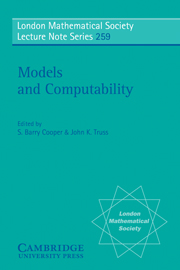Book contents
- Frontmatter
- Contents
- Preface
- Continuous Functionals of Dependent and Transfinite Types
- Degree-Theoretic Aspects of Computably Enumerable Reals
- Simplicity and Independence for Pseudo-Algebraically Closed Fields
- Clockwork or Turing U/universe? - Remarks on Causal Determinism and Computability
- A Techniques Oriented Survey of Bounded Queries
- Relative Categoricity in Abelian Groups
- Computability and Complexity Revisited
- Effective Model Theory: The Number of Models and Their Complexity
- A Survey on Canonical Bases in Simple Theories
- True Approximations and Models of Arithmetic
- On the Topological Stability Conjecture
- A Mahlo-Universe of Effective Domains with Totality
- Logic and Decision Making
- The Sheaf of Locally Definable Scalars over a Ring
- Human Styles of Quantificational Reasoning
- Recursion Theoretic Memories 1954–1978
- Fields Definable in Simple Groups
- A Combinatory Algebra for Sequential Functionals of Finite Type
- Model Theory of Analytic and Smooth Functions
Simplicity and Independence for Pseudo-Algebraically Closed Fields
Published online by Cambridge University Press: 17 May 2010
- Frontmatter
- Contents
- Preface
- Continuous Functionals of Dependent and Transfinite Types
- Degree-Theoretic Aspects of Computably Enumerable Reals
- Simplicity and Independence for Pseudo-Algebraically Closed Fields
- Clockwork or Turing U/universe? - Remarks on Causal Determinism and Computability
- A Techniques Oriented Survey of Bounded Queries
- Relative Categoricity in Abelian Groups
- Computability and Complexity Revisited
- Effective Model Theory: The Number of Models and Their Complexity
- A Survey on Canonical Bases in Simple Theories
- True Approximations and Models of Arithmetic
- On the Topological Stability Conjecture
- A Mahlo-Universe of Effective Domains with Totality
- Logic and Decision Making
- The Sheaf of Locally Definable Scalars over a Ring
- Human Styles of Quantificational Reasoning
- Recursion Theoretic Memories 1954–1978
- Fields Definable in Simple Groups
- A Combinatory Algebra for Sequential Functionals of Finite Type
- Model Theory of Analytic and Smooth Functions
Summary
Simple theories were introduced by Shelah in 1980 in [S]. Recently, Kim and Pillay proved several important results on simple theories, which revived interest in them. Several people are now actively studying these theories, and finding analogs of classical results from the stable context.
A famous conjecture states that all stable fields are separably closed. Thus, examples of fields with a simple theory are of particular interest. The first examples of fields with a simple theory were obtained by Hrushovski in [H], see also [HP]: the perfect bounded pseudo-algebraically closed fields (a field is bounded if for each integer n it only has finitely many Galois extensions of degree n). In [CP], the assumption of perfection on the field was dropped.
The model theory of pseudo-algebraically closed fields (henceforth called PAC) was extensively studied in the seventies and eighties, starting with the work of Ax on pseudofinite fields [A], up to a complete description of the elementary invariants given by Cherlin, van den Dries and Macintyre [CDM], see also the papers by Ershov [E1,E2]. Besides the classical fields (real closed, algebraically closed, separably closed, p-adically closed), the PAC fields form maybe the best known class of fields, in any case the only class with explicit invariants.
In this paper, we show (Theorem 3.9): a PAC field whose theory is simple, is bounded. Note that if the assumption of pseudo-algebraic closure could be dropped, then the conjecture on stable fields would be proved: Poizat ([Po2], Thm. 5.10) has shown that a stable field is either separably closed or has infinitely many extensions of degree n.
- Type
- Chapter
- Information
- Models and Computability , pp. 41 - 62Publisher: Cambridge University PressPrint publication year: 1999
- 9
- Cited by

